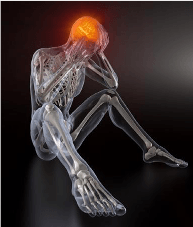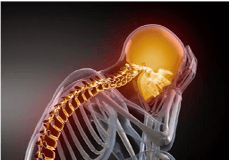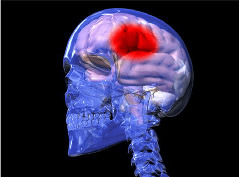Head
Head Pain Treatments
DO YOU SUFFER FROM HEADACHES?

If you have a headache that has lasted more than 48 hours, please contact your GP. Provisional diagnosis will be done by your GP or a headache specialist physiotherapist, with the diagnosis being made by a neurologist and brain MRI.
If you constantly suffer with headaches, you may have one of the following conditions:
CLUSTER HEADACHE
 A cluster headache is a less common type of recurrent headache than a migraine, and does not have all the migraine symptoms. The pain in this type of headache is shorter and less severe, and you may also have a watery or bloodshot eye. The
A cluster headache is a less common type of recurrent headache than a migraine, and does not have all the migraine symptoms. The pain in this type of headache is shorter and less severe, and you may also have a watery or bloodshot eye. The
symptoms of cluster headaches are characterised by unilateral (one sided) pain, although for some people the side can vary from time to time. The pain is usually centred over one eye, one temple, or the forehead, though it can spread to a larger area, making diagnosis harder. The pain is said to be worse than giving birth.
During a bout of cluster headaches, the pain is often experienced at a similar time each day, often starting at night and waking people up one to two hours after they have gone to sleep. The pain usually reaches its full intensity within 5 to 10 minutes and then continues at this agonising level for between 30 and 60 minutes. For some people, the pain can last for 15 minutes, whereas for others, it has been known to last for up to three hours. It then stops, usually fairly abruptly.
I recently talked with a sufferer, and he explained to me that he was one of the 80% of people with head pain lasting for 4 to 12 weeks a year, often at the same time and often in the spring or autumn. It usually disappeared
for several months (and sometimes years) but it would then come back again. This is known as an episodic cluster headache, and the reason for this seasonal timing is not completely known, although it is one of the key aspects of diagnosis and may involve the hypothalamus. The remaining 20% of people do not have these pain free intervals and are said to have 'chronic cluster headaches'.
Provisional diagnosis is often done by your GP or physiotherapist. As physio and painkillers are ineffective, oxygen is one of the safest ways to treat a cluster headache. You need to breathe the oxygen in at a rate of between 7 and 12 litres per minute, and the treatment usually starts to work within 15 to 20 minutes. For some people, the attack is delayed rather than stopping altogether.
MIGRAINE
The most common kind of intense head pain is a migraine, and these can last anywhere from between 4 and 48 hours. It is often felt through a throbbing sensation, and it affects just one side of the head. You can experience vomiting and sensitivity to light and smells, but at its worst your vision is affected with flashing lights and blindness, as well as speech problems and a tingling in the face or fingertips. I remember getting migraines in my 30's when I was running an outpatient department with crazy long waiting lists. I'd had a recent whiplash injury, and my vision used to go suddenly hazy - not fun when you're driving on a motorway.
About one fifth of people with migraines who seek advice believe that cheese, chocolate, and alcohol can trigger the attacks, so food allergy testing can help. My favourite treatment options are Chinese Acupuncture, Gunn IMS dry needling, mobilisations to the neck, nutritionist advice, and for the ladies, a hormone check-up. NLP (neurolinguistics programming) can also help where stress is involved. GP prescribed medicine may be needed too.
TENSION HEADACHE
This is a more common, fairly harmless headache, usually occurring when tired and stressed. It lasts up to six hours and gives pain on both sides of the head, with no other symptoms. Tension headaches are much more common than the cluster headache, thank goodness.
For tension headaches, the provisional diagnosis is done by your GP, and treatment can include: Chinese medicine, hydration, Acupuncture, Gunn IMS, mobilisations to the neck, nutritionist advice, NLP, relaxing massage, Indian head massage, stress counselling, and reiki.
GP prescribed meds should be used only as a last resort. If headaches occur, the cause needs to be found and addressed.
TRIGEMINAL NEURALGIA
 The trigeminal nerve supplies the lower jaw and teeth and can give short, sharp pains like a hot poker when irritated. The trigeminal nerve is the fifth cranial nerve and its function is to send pain messages to the brain. When the nerve malfunctions, pain messages are sent at
The trigeminal nerve supplies the lower jaw and teeth and can give short, sharp pains like a hot poker when irritated. The trigeminal nerve is the fifth cranial nerve and its function is to send pain messages to the brain. When the nerve malfunctions, pain messages are sent at
inappropriate times and the pains can be of great severity. It can be triggered by chewing, speaking, or even by the wind.
This condition is more common in older people, probably because the arteries supplying the back of the brain where this nerve enters become stretched and may touch the nerve. It is an extremely severe facial pain that tends to come and go unpredictably in sudden shock-like attacks, and whilst treating the area, even light touch is described as being stabbing, shooting, excruciating, or burning. It usually only lasts for a few seconds, but there can be many bursts of pain in quick succession. It is not easy to treat, and I know; I recently eased - not cured - this condition in a delightful gypsy lady who was losing the battle with this unpleasant condition.
Treatment options that may help the symptoms include: Chinese medicine, electro-acupuncture, TENS, Gunn IMS, NLP, relaxing massage, and GP prescribed medicines. As normal painkillers such as Paracetamol are not effective in treating trigeminal neuralgia, you will normally be prescribed an alternative medication, such as an anticonvulsant (usually used to treat epilepsy) to help control your pain.
These medications were not originally designed to treat pain, but they can help relieve nerve pain by slowing down electrical impulses in the nerves and reducing their ability to transmit pain.
Microvascular decompression (MVD) is an operation that can help relieve trigeminal neuralgia pain without intentionally damaging the trigeminal nerve. Instead, the procedure involves relieving the pressure placed on the nerve by blood vessels that are either touching the nerve or wrapped around it. An alternative way to relieve the pain by damaging the trigeminal nerve that doesn't involve inserting anything through the skin is through stereotactic radiosurgery. This is a fairly new treatment that uses a concentrated beam of radiation to deliberately damage the trigeminal nerve where it enters the brainstem.